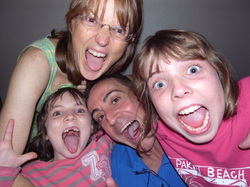
 The Chinese have an expression along the lines of: After three days guests start to smell like off fish. In Australia, we all just went a bit crazy. Our fabulous holiday with Lesley, Steve and Rita came to an end yesterday, after 26 days in Sydney. This time together was a real tonic and we're going to miss them enormously. Before leaving we made sure their Skype was set up and running, and we shall endeavour to keep in touch more regularly than recent years.
2 Comments
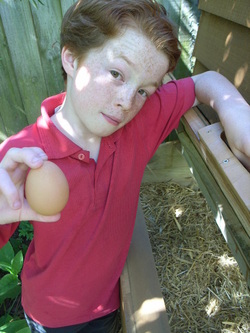 Here's Neal with an egg from one of the five eggs produced daily by the chickens which have recently been installed here at Thorrington Road. What with Andrew bringing in the meat (he was off shooting hares with Neal the other night), rows of neatly growing spinach and salad in the vegetable beds, lemon, plum and apple trees in the garden, grape vines and strawberry patches, it really does seem like a self-sufficiency heaven here in Christchurch. The weather's always perfect and Susie even has a touch of Felicity Kendall about her (any resemblance between Andrew and Richard Briers is completely non-existent!). 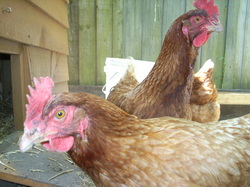 The five chooks are a recent addition to the family. But despite having two vets as parents the Hay/Kirkwoods have struggled to give the fowl obviously feminine names. For example: Bob, Bill, Big Z, Maverick and - thank goodness - Betty. Freda and Edie think some more girly names are called for. What do you think?
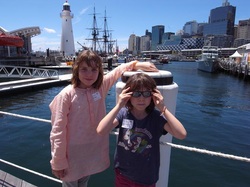 Freda & Edie at Darling Harbour We packed a picnic and had a day of sight-seeing today, taking in Cockle Bay, the Queen Victoria Building, Hyde Park and the fabulous Maritime Museum. We also enjoyed several circuits on the monorail - best to get one's money's-worth, don't you think?
Darling Harbour is currently host to a number of great vessels, including some naval ships and submarines, as well as HMB Endeavour - a replica of James Cook's tall ship [next to lighthouse]. If you have some spare cash you can sign up for a leg of Endeavour's first circum-navigation of Australia, in 2011. One of the museum highlights is an exhibition - On Their Own - about Britain's child migrants to Australia. From the 1860s onwards over 100,000 British children were sent to Commonwealth countries through child migration schemes, supported by the governments and organised by charitable and religious organisations. Most of the children were told that they were orphans and had no choice but to leave. Now adults, many migrants are discovering living parents and relatives in the UK and trying to come to terms with their past. The photographs, diary accounts and interviews with the child migrants decades on, reveal that although many children were removed from a life of economic hardship, they embarked on a new life of suffering and sorrow, which a suitcase of new clothes didn't compensate for. These children helped form the backbone of the Australian economy. This was an exceptionally moving encounter with British and Australian history and I wasn't the only visitor with tears in my eyes.  It was very refreshing to visit Sydney's 'Chinatown' near the city centre - lots of bargains, shops full of dinky trinkets, massage parlours, street food and, what I've really missed, CHINGLISH! I thought our days of Chinglish blog entries were over but the first shop we came across in the indoor market displayed this sign . Not the funniest translation we've seen but it brought on pangs of homesickness for Simao. A Mah Zhong set was one of the variety concepts for sale, priced $88, about ten times the price as in China. Wish I'd bought one while I was there!
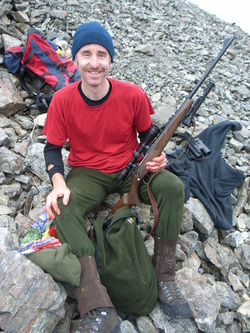 This is Andrew, whose home we're staying in, on and off, while here in Christchurch. Like a lot of Kiwi blokes he's a keen hunter, so I was really chuffed when he suggested we get together for a day on the hill up at Arthur's Pass. With his 'Vietnam' moustache (a temporary feature) I thought he really looked the part! The day up on Goat Hill turned out to be one of the best - for me a classic initiation into NZ chamois hunting. We left the road at 5.30am, and after a couple of hours of thrashing upwards to the bushline we emerged onto the rocky lower slopes of Goat Hill. Would it prove to be an appropriately named hill? I tagged along behind Andrew as we traversed around the long southern ridge stopping every so often to scan the ground ahead for unsuspecting chammy or deer. Nothing. Higher up Andrew sniffed the air and declared that the wind was now blowing in the wrong direction - the whiff of my unwashed body would now be reaching the nostrils of any beasts further up the hill. So we plodded up the ridgeline, disconsolate now, and consoling ourselves that we might bag the summit of the hill instead (1656m). 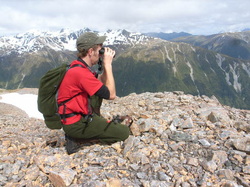 Scanning the hillsides for chammy. Suddenly we spotted something on the ridge, maybe 800m ahead. Binos out - yes, a chammy, seemingly unconcerned by our presence. Now the stalk began... Andrew's mood changed: his eyes grew wide with youthful enthusiasm, nostrils flared, and he started pointing out chammy prints in the snow. A creature at one with his environment, he stealthily crept around the side of the ridge, pausing only to reprimand me for not crouching low enough or making sudden movements. We reached the point in the ridge where the chammy had been grazing, but there was no sign of its presence. More dejection - we continued up and along the narrow, rocky, scrambly ridge, Andrew out of sight in front. Suddenly "boom" - the sound of the rifle was surprisingly loud, making me jump out of my skin! Another report, then I staggered over the rise to see what had happened...  Andrew Hay - marksman... This was what I saw. A grinning Andrew, happy because he'd just hit a moving target at 150 metres. It was a remarkable piece of marksmanship. The chammy had been running away across the scree and had just crossed the snow slope (lower left in photo) when Andrew took his shot. Very impressive shooting. I had a look through the telescopic sights and the target still looked very small! 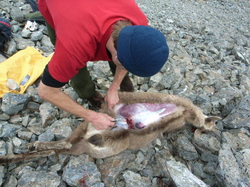 Conducting the post-mortem. The beast was a young female, very good tender eating apparently. Andrew quickly started on the butchering, taking the prized back steaks first then deboning the legs. We didn't take any kidneys or liver because of the way the chammy had been shot. There was a fair weight of meat filling Andrew's rucksack on the way back down the hill. As Andrew said, "I've three hungry boys to feed back home." For me, I'd never been so close to seeing an animal killed for meat before, apart from helping slaughter the occasional chicken in China. When I heard the shots and saw the lifeless body of an animal we'd watched happy in its mountain life only minutes before I must admit to feeling a little unsure of what had just happened. But I've been a meat-eater all my life, so I guess any doubts would have to be regarded as completely hypocritical! I've tasted Andrew's game stew previously and it's really very delicious. 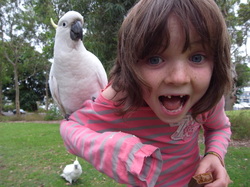 We aren't the only ones that like Tim Tam biscuits. While in the Royal Botanical Gardens today we attracted a flock of Cockatoos, a pair of Rainbow Lorikeets, some Noisy Myna birds and a load of pigeons. After having a munch of our sandwiches [from our hands], they then wanted the Tim Tams and became bolder and bolder. At one point Freda had a Cockatoo on her shoulder, her head and a Lorikeet on her hand. If you stop feeding the Cockatoos, they nibble your ear to prompt you to give them more. The Lorikeet are a little gentler, and opt for hair-pulling instead. After our picnic we spent a couple of hours in the gallery of New South Wales. The highlight was the classic painting section, where Freda and Edie were introduced to some great masters, including Constable and Rubens. An entertaining and educational day out.
After Monday's exertions on Mount Rolleston, I planned another 3-day tramp into the wilds of the Edwards and Hawdon Valleys. The guts of the trip was the traverse of 3 cols and a huge area of rockfall caused when part of a mountain fell down in a 1929 earthquake. It's now called Falling Mountain. I was a bit worried that they hadn't renamed it Fallen Mountain - this present tense nomenclature perhaps indicated some danger I should concern myself with?! But in the end nothing fell on me except for a big grey cloud which required some tricky navigation...  Edwards Hut, built 1969, Alt. 1065m TUESDAY Day 1: Crossing the Bealey and Mingha Rivers was quite tricky - even at this low water level. They must be impossible in even a small flood. Then, five hours in forest and valley flats up to this lovely hut, Edwards Hut. In residence were two friendly DOC workers, Tim and Sam, who had been recutting the path (the beech forest grows back after 2 or 3 years). They had managed to wangle a chopper ride up there, so I was very jealous of their food supplies: tins and fresh meals, and FRESH milk. Very civilised. Tim even invited me to a BBQ back in Arthur's Pass on Friday night. Kiwis (the people) are generally a very friendly, open bunch of people. That night there were kiwis (the birds) calling in the bush outside the hut. 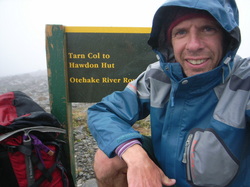 A handy, and unexpected, DOC sign... WEDNESDAY Day 2: A little disappointing as the cloud and rain prevented me from seeing much of the rockfall. But traversing the kms of loose scree from the Taruahuna Pass to the bottom of Tarn Col was certainly a testing and worrying experience. Just as I was getting worried I hit upon a line of cairns and poles and this handy DOC sign telling me which way to go! Much of the rest of the way was "creek-bed travel" - one way of describing hopping around on boulders, crossing and recrossing streams, and generally wetly grovelling about. From the third and final col, Walker Pass, the way onwards to the new Hawdon Hut was much easier underfoot, but difficult to keep to the "path" in tussocks and thick scrub. Tramping in NZ really is a unique experience. 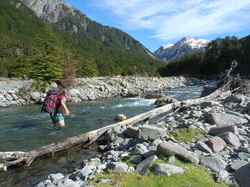 The camera tripod comes in useful again. THURSDAY Day 3: An easy day walking out to the road and hitching 25km back to Arthur's Pass. The Hawdon River valley was much easier to travel than I'd anticipated (easy grassy flats and gravel) though there were still a few river crossings to contend with. But best of all I spotted a kakariki (aka yellow-crested parakeet) in the forest. They're reasonably rare but there are quite a few up here in the Canterbury high country. This little bit of bird-spotting made my day.
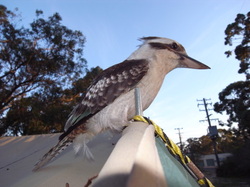 The kukaburra was a frequent visitor to our awning at the campsite, and we still here them in the city. They make an incredible range of sounds from chuckling and chortling to roaring with laughter. They are also sociable birds, chatting to each other between trees as well as keeping a close eye on human activity. They particularly like BBQs and are partial to the odd sausage. Although less 'exotic' and eye-catching than their parrot family companions in the forest, they are one of my favourite birds here. The only down side is that their wake-up call begins at sunrise which, these days, is about 5:30 am.
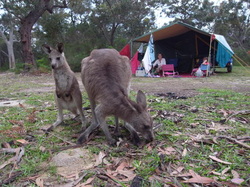 One of our regular visitors with her joey Before coming to Australia I let slip to Lesley on the phone that I really wanted to see kangaroos in the wild. I remember her stories from years back about the dangers of kangaroos on the road at dusk, and this made a big impression on me. Forget surfing, scuba diving, the outback - just give me a Skippy sighting and I'd be happy. Well, Lesley and Steve remembered a campsite they've stayed at over the years, about a 3-hour drive South of Sydney, down the Pacific highway. This is where us 4 girls spent the weekend, at Bream Beach holiday park. We took the camper-trailer, which was our home from home for three nights. It was fantastic. Best of all were our neighbours - kangaroos with their joeys, laughing kukaburra, possums, cockatoos and various other forms of 'exotic' wildlife. It poured with rain on the last night, flooding part of the tent, but nothing could dampen our spirits. Here's what Freda has to say: We went to the beach every day . It was excellent. The water was quite cold at first but we soon got used to it. Some of the waves were quite small but some were huge. Lesley taught us how to dive under the waves so that they didn't knock us over. When we were at the beach we did body surfing in the waves. I can't wait to go to Bondai beach. It was great to see these marsupials up close. It's one thing reading about animal behaviour in a book, it's another to see it up close. What amazes us most was the size of joey that could still fit into the pouch. Another was the way the mother tightened the muscles around the pouch in order to be able to bounce around. The rest of the time the pouch was virtually resting on the ground under the weight. See More Vidoes for the possum-feeding footage.
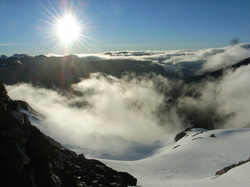 Sunrises don't get better than this. I've heard it said, "There are old climbers, and bold climbers, but no old bold climbers" and I guess there's a bit of truth in that. I was pondering this little bit of mountaineering lore while descending from Avalanche Peak today. I left the bach at 3.20am, an Alpine start because I was heading for the Rome Ridge of Mount Rolleston, a classic snowy ridge on the nearest highest peak in Arthur's Pass. It was all going well: I burnt off a team of 7 kiwi students on the steep thrash up through the bush; the wind and early morning cloud sank back to reveal a stunning cloud inversion; and the route ahead looked interesting, but not too spicy - just right I thought for a solo ascent, within the comfort zone. Higher up I was having my doubts as any snow which had been in the sun, even at this early hour, was deep and soft - not boding well for a descent later in the day. I'd just started descending round a steep buttress at around 1900m at the top of the E Crow Glacier when I sunk up to my waist in a small hole, a tiny little tension slot just below the bergschrund. It wasn't at all life threatening, but the incident made me realise that this maybe wasn't a good place to be alone. So I turned back... 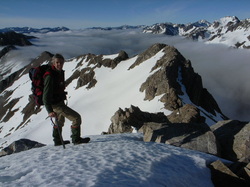 My mini-tripod is handy for moments like this. As it turned out the day wasn't wasted. The views from up there, so early in the morning, were spectacular - I even saw a Brokken Spectre. Plan B was put into force, a ridge walk southwards to Avalanche Peak, the classic tourist daytrip from the village. It was great fun, a bit like Torridon ridges in winter, and I was "over the hill" and back down in the valley by 1.30pm. I really felt my knees in that final descent, something I've never really felt so hard before. Must be getting older... |
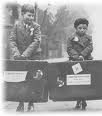
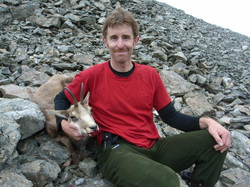
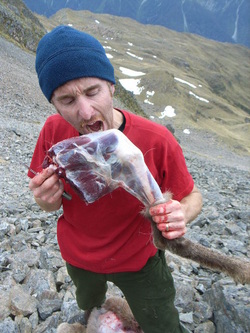
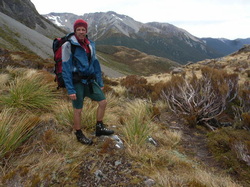
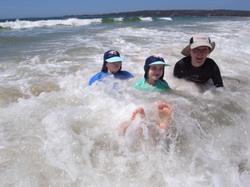
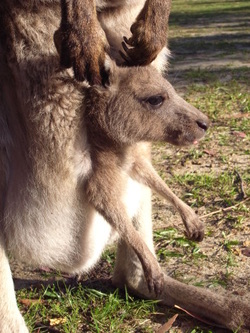
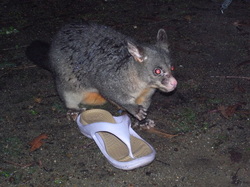

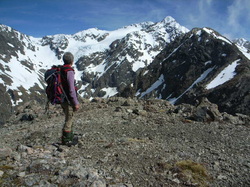
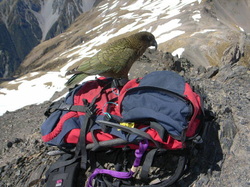
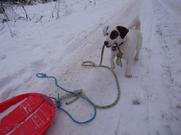
 RSS Feed
RSS Feed